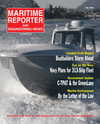
Page 42: of Maritime Reporter Magazine (May 2006)
The Marine Enviroment
Read this page in Pdf, Flash or Html5 edition of May 2006 Maritime Reporter Magazine
42 Maritime Reporter & Engineering News
Members of the International Salvage Union (ISU) recovered over 875,000 tons of pollutants during sal- vage operations last year. During 2005, emergency assistance was provided worldwide for 247 vessels with cargoes and bunkers threatening pollution (a mar- ginal fall of some 7.5 percent on the 266 casualties recorded in the survey for 2004).
The results of the ISU's latest annual Pollution
Prevention Survey show that oils, chemicals, other pol- lutants and bunker fuel recovered last year totaled 875,331 tons, as against 734,582 tons in 2004. This amounts to an increase of just over 19 percent.
ISU President Hans van Rooij said: "Once again, our members have demonstrated their effectiveness in defending the marine environment. In 2005, the recov- eries included over half a million tons of crude oil."
Forty-six of the ISU's 51 members contributed data for the latest annual survey. In 2005, ISU salvors responsible for the 247 salvage assistances recovered the following: • 61 percent, crude oil (and diesel oil) — 533,281 tons (452,304 tons in 2004) 7 percent, chemicals — 60,147 tons (34,752 tons) 23 percent, other pollutants (e.g. gasoline, slops, dirty ballast, etc) — 201,960 tons (152,235 tons) 9 percent bunkers — 79,943 tons (95,291 tons) "The volume of crude oil recovered saw an increase of just over 17 percent on the 2004 figure of 452,304 tons," said Hans van Rooij. "The recovery of chemi- cals, at 60,147 tons, was an increase of over 73 percent on the 2004 figure. The volume of bunkers recovered has in the past been remarkably consistent - in the range of 60,000-70,000 tons. In 2004, however, the fig- ure increased to 95,291 tons. Last year it fell back to 79,943 tons, a decrease of over 16 percent on 2004."
The ISU's Pollution Prevention Survey began in 1994. In the 12 years to end-2005, ISU salvors recov- ered 12,617,837 tons of potential pollutants. This con- sists of 9,904,369 tons of crude oil (and diesel oil), 719,116 tons of chemicals, 821,778 tons of bunkers and 1,172,574 tons of "other pollutants" (recorded as a sep- arate category for the first time in 1997).
During 2005 there was an increase in the number of tanker salvage operations: 34, as against 24 in 2004.
The largest tanker service involved a crude carrier laden with 133,500 tons of Arabian Crude.
Last year saw a significant decrease in the number of casualties (tankers and other vessels) requiring the ship-to-ship transfer of cargoes and/or bunkers. The total fell from 36 cases in 2004 to 20 in 2005. None of these transfers involved a significant tonnage.
Last year the single most used form of contract was
Lloyd's Form, which was used in 81 services (over 30 percent of the total number of assistances). There were also 44 cases using other forms of salvage agreement, such as the Japan Form. In addition, there were 11 wreck removal operations, 27 common law salvage claims and 84 services carried out on a lump sum or daily hire basis.
Salvage and the Marine Environment
ISU Salvors Recover Half a Million Tons of Oil
Pictured is Vermontborg, a newbuilding that was under tow for completion in a Dutch yard when she grounded off Guernsey in January 2003. (Source: International Salvage Union)
MR MAY2006 #6 (41-48).qxd 5/8/2006 11:56 AM Page 42

 41
41

 43
43
